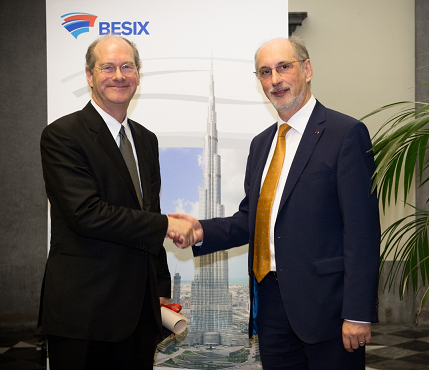News

Gustave Magnel Gold Medal to William Baker
Luc Taerwe (right), chairman of the scientific jury, congratulates William Baker (left)
Prof. Gustave Magnel was active at Ghent University (Belgium) from 1919 until his passing away in 1955. In the early 1940's he performed extensive research on real scale prestressed concrete beams in his lab in order to elaborate design methods for this new material. He also developed his own anchorage system which was used until the mid-1960's in Belgium. He gave many lectures in several countries in which he explained in a simple way the principles of prestressed concrete. He was also instrumental in the design of the first prestressed concrete bridge in the USA, the Walnut Lane Bridge in Philadelphia and he was the author of the first English textbook on prestressed concrete. He designed one of the first PC railway bridges in Europe and the first statically indeterminate PC bridge in the world. In the 1950's many engineers from abroad spent some time in Magnel’s lab in Ghent to perform research and to get acquainted with practical realizations. He was one of the founders of FIP in 1952. The laboratory he founded in 1926 has been named after him after his death and is still one of the leading labs on concrete research.
In order to commemorate Prof. Magnel's exceptional achievements, the Association of Engineers of Ghent University (AIG) bestows the “Golden Medal Gustave Magnel” every fifth year on the designer of a structure, which is deemed to be an important and remarkable application of reinforced or prestressed concrete. On December 12, 2014 the twelfth Medal was conferred to William Baker for the project “The Burj Khalifa and the buttressed core”. William Baker is the structural engineering partner for Skidmore, Owings and Merill (SOM) in Chicago and he is widely regarded for his work on extremely tall buildings and long span roof structures. Baker’s career has also been marked by various collaborations with artists. Baker’s many skyscraper projects include the AT&T Corporate Center (Chicago 1989) and Cayan Tower (Dubai 2009). With a height of 828 m, the Burj Kalifa skyscraper, as of today, is the tallest man-made structure in the world. SOM was responsible for the tower’s architecture and engineering, with William F. Baker as chief structural engineer. To support the tower’s record breaking heights, he developed the “buttressed core” structural system, consisting of a hexagonal core reinforced by three buttresses that form a Y shape.
The previous eleven recipients were N. Esquillan (1959), P. Blokland (1963), F. Leonhardt (1968), U. Finsterwalder (1973), R. De Keyser (1979), H. Wittfoht (1984), R. Greisch (1988), O. Olsen (1994), M. Virlogeux (1999), J. Schlaich (2004) and J. J. Arenas (2009).














No comment
Log in to post comment. Log in.